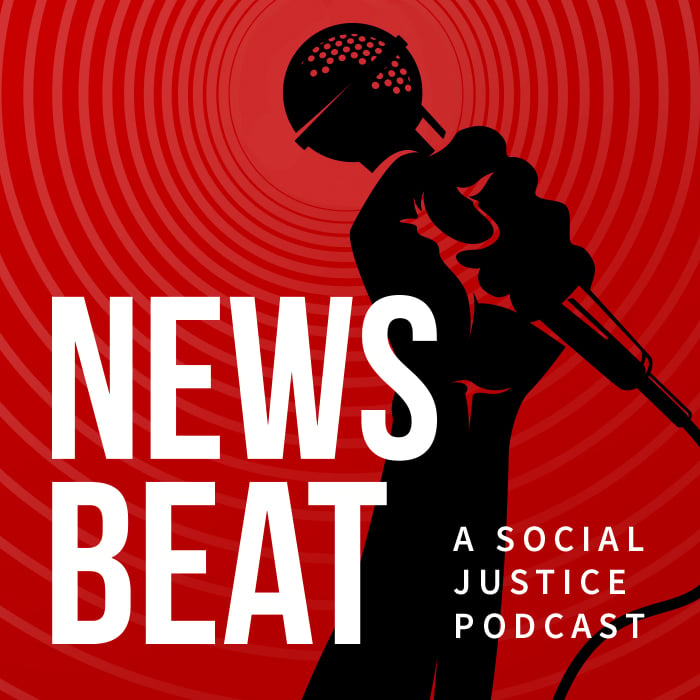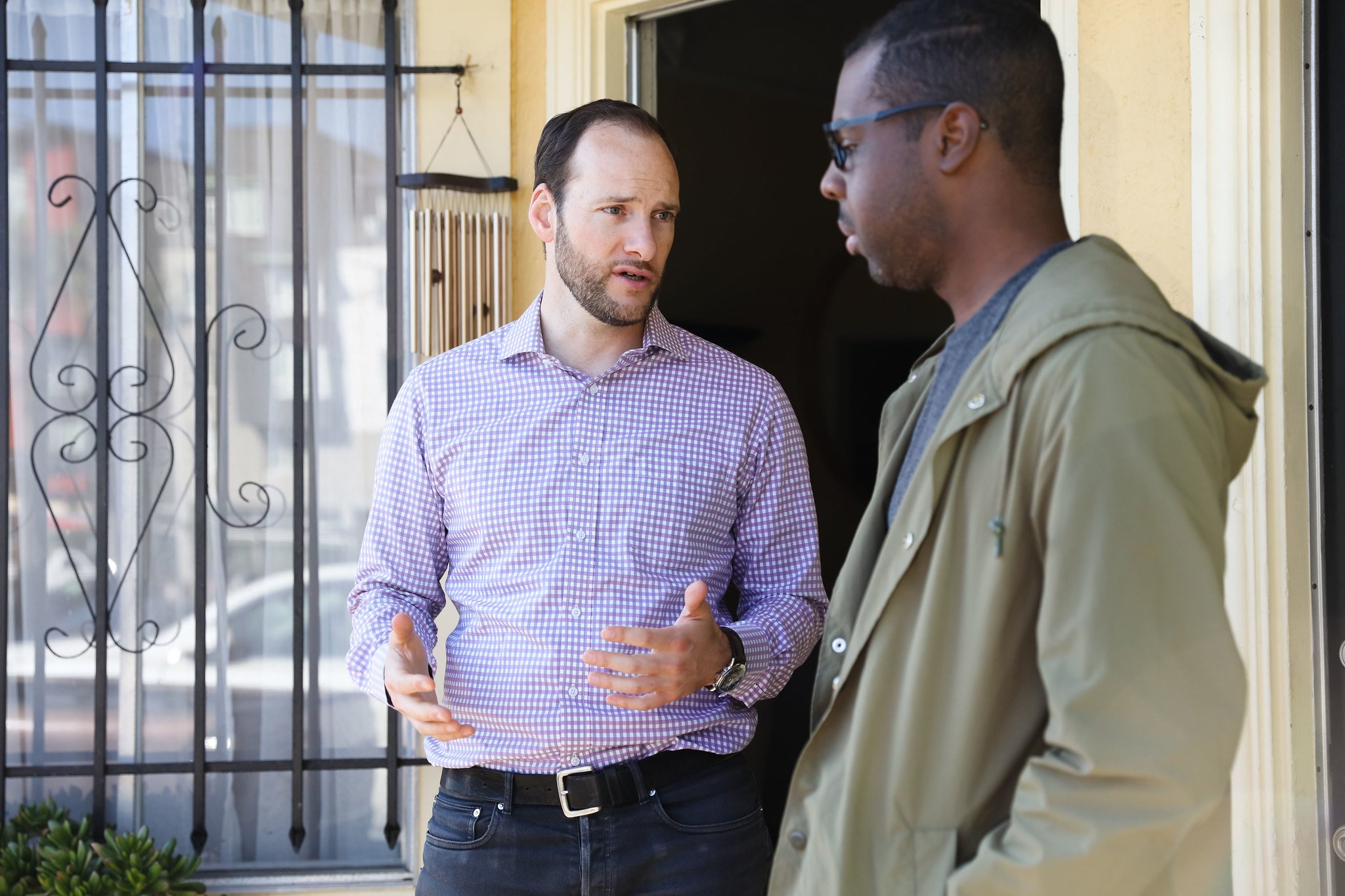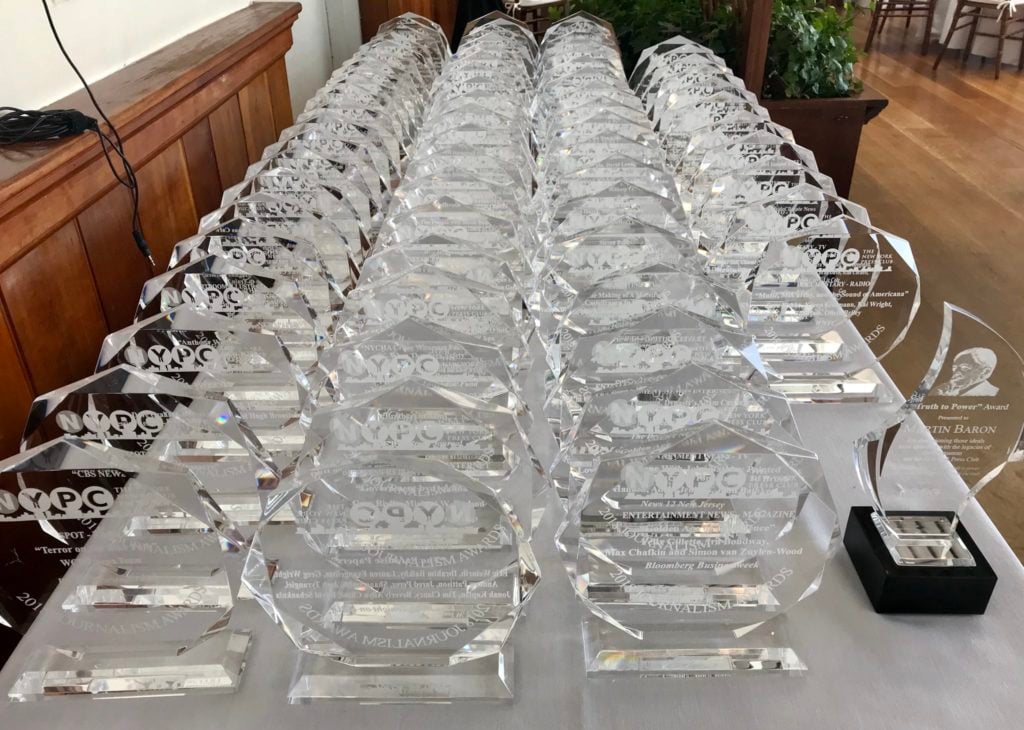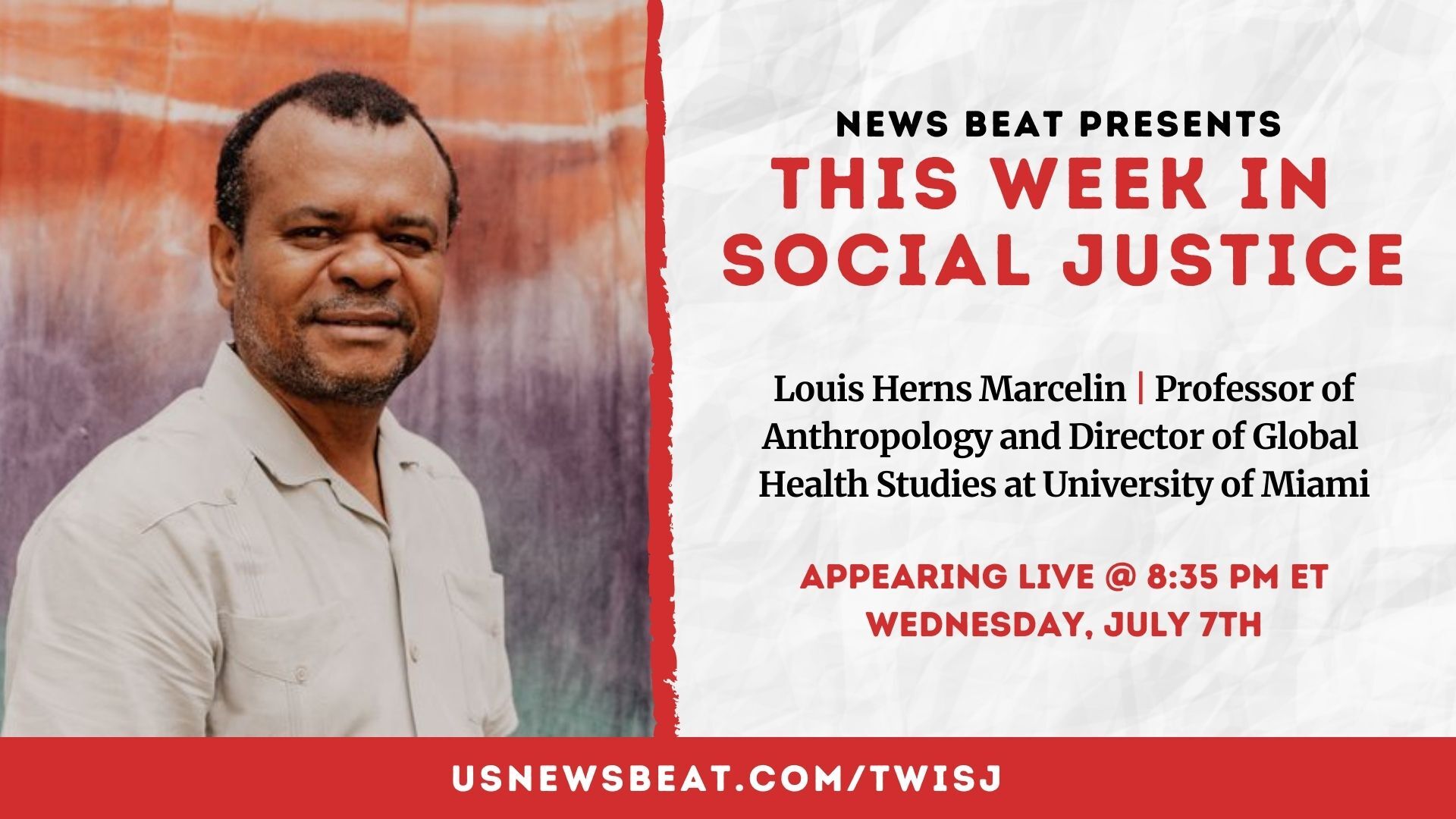Listen to this special bonus episode of News Beat podcast featuring an interview with San Francisco District Attorney Chesa Boudin (transcript below).
Listen to the podcast by subscribing to News Beat on your favorite pod app.
In November 2019, Chesa Boudin pulled off a stunning victory in the race for San Francisco District Attorney.
Boudin, a career public defender, had campaigned on a seemingly radical reform agenda aimed at reversing years of mass incarceration, uplifting victims, and ending racial disparities in the criminal justice system.While district attorney candidates are increasingly adopting a progressive platform, convincing enough voters that overdue reforms will keep them safer remains a challenge. Such skepticism can partly be attributed to decades of tough-on-crime policies reinforcing in many voters that suppressing crime means filling up jails and prisons.
"I ran my race, as many progressive prosecutors across the country did, on a platform committed to ending mass incarceration. And I did it because I believed then as I do now, that mass incarceration makes us less safe."
Boudin's message had resonance in a city with significant racial disparities in policing. Not only did he prevail over a crowded field, but he wasted little time fulfilling campaign promises, including ending cash bail and instituting sentencing reforms.
We interviewed then-candidate Boudin last year for an episode on restorative justice, which seeks to hold offenders accountable outside of the courts. We recently caught up with Boudin to discuss reforms his office has adopted and the challenge the coronavirus (COVID-19) pandemic poses.
The following is a transcript of our conversation with Boudin, edited for clarity.
As a former public defender, what has surprised you the most about this side of the law?
"It's been a steep learning curve and I love being in a steep learning curve environment. Definitely learned a lot about how the system works, about how sometimes the system doesn't work at all. I think the thing that has surprised me the most, and I say that, even though it was something I was aware of, and I talked a lot about it during my campaign, but it has nevertheless continued to surprise me, is how little the system actually cares about healing and supporting victims. You know, there's not resources for it. There's not systems set up for it. And all too often victims are simply used as pieces of evidence. And we see it every day, in ways that are really sad and really frustrating. You know, somewhat part of that is the ways in which we talk about public safety, which is the focus of my job, and every district attorney's job, and yet, we as a system, and we as district attorneys simply don't have the tools to meaningfully support successful reentry after people are released from jail or prison. And so we're setting ourselves up for new crimes and for people to be victimized again, and again."
Can you explain the reasoning for your near-complete ban on sentencing enhancements in San Francisco?
"Well, we implemented a policy to, as a presumption, of course there's always exceptional cases, but as a presumption to no longer charge three strikes, sentencing enhancements, or other similar enhancements based on prior conduct. And also to stop charging gang enhancements. And let me tell you a little bit about why we made that decision. The basic goal was to hold people accountable for what they did, in this case that we're prosecuting rather than who they are, what neighborhood they grew up in, or something that we've previously punished them for in the past. This change in policy was part of my broader commitment to end mass incarceration, and the kind of draconian prison sentences that make the United States stand out as a serious outlier compared to any other civilized country in the history of the modern world.
We're covering COVID-19 from a social justice lens. Check out our coverage.
"We also relied on data to make these policy changes. A Stanford Computational Policy Lab study a few years ago, found that the use of these sentencing enhancements in San Francisco accounted for about one out of every four years served in jail and prison. In other words, it was a significant driver of mass incarceration. And it's a driver of mass incarceration that's explicitly exacerbating racial biases. What do I mean by that? Forty-five percent of inmates serving life sentences in California, under the three strikes law, are black. This is a law that is applied disproportionately against mentally ill, physically disabled defendants, and against African Americans. We don't need those severe punishments to keep ourselves safe. We don't need them to hold people who commit crimes accountable, and they undermine trust between law enforcement and the communities that we've sworn to serve and protect. The issue with gang enhancements and allegations is in some ways even more problematic from a racial justice lens. If someone commits a murder, we have the ability under California law to seek a life sentence, even without a gang allegation or gang enhancement. So we already have the ability in serious cases to impose serious consequences. But gang allegations and gang enhancements are tools that prosecutors and law enforcement have used for many years, to criminalize relationships, to criminalize neighborhoods, to criminalize cultures, and so the kind of evidence that we see introduced in gang cases, in courts across California, is social media postings with people socializing with their cousin or with their loved one, are things like people wearing clothes or being on a street that they live in because it's a public housing project. It's evidence that we almost never see brought against white defendants.
"Forty-five percent of inmates serving life sentences in California, under the three strikes law, are black."
"In San Francisco, for example, I haven't been able to find a single case in the last 10 years, where a gang allegation has been brought against someone who's white. And so in order to move away from the racial bias, in order to move away from the ways in which the criminal justice system undermines poor communities and communities of color's willingness to work with law enforcement, we decided to stop using those unnecessary and discriminatory tools."
RELATED: Read our series on mass incarceration and listen to our criminal justice podcast playlist.
How much has the 2016 DOJ study on policing in San Francisco informed your decisions?
"We definitely looked at that report incorporated its findings. But we didn't just rely on that. We looked at also a wide array of academic research. We looked at best practices from other jurisdictions. And we looked at the history of these policies in San Francisco. You know, driving while black is a phenomenon that is not new or unique to San Francisco. It's a concept that is widely understood by anybody who is or is perceived to be black, who's ever driven a car anywhere in the United States, people are treated differently based on how they look and the color of their skin. They're treated differently by government, and by law enforcement, every day. We want to disincentivize that kind of racial profiling. And we want to encourage the San Francisco Police Department to take decisive action to move away from the kinds of policies and practices that led to the findings in that Department of Justice report and so many other reports that have been published before and since detailing these problems in San Francisco. The Department of Justice under President Obama investigated the San Francisco Police Department, and it found that there were hundreds of urgently needed reforms that had to be made, and a series of those reforms pertains specifically to traffic stops. [Read the full Collaborative Reform Initiative] Here we are 10 years later, and virtually none of those changes have been made. It's time that people in San Francisco, no matter what color their skin is, feel safe driving down the street."
Explain your decision to end cash bail and your office's reliance on a controversial risk-assessment tool.
"One of the first things I did after taking office was prohibit my staff from ever putting a price tag on freedom. We moved away from a wealth-based system to a risk-based system. We do not want someone in jail simply because they're poor. And we don't want someone who's dangerous out of jail simply because they have the money to post bail. And so what we did was we simply said, 'We're going to make a decision. If we believe that someone is too dangerous to be released, no matter what conditions we impose on them, if we believe the evidence of their guilt is so strong, then we're going to ask the court to detain them. And if we believe on the other hand that there are less-restrictive conditions that could allow the person to safely be released to the community, then we are going to ask for those less-restrictive alternatives.' And it's not going to have anything to do with wealth. That's why we no longer ask for money bail.
"We moved away from a wealth-based system to a risk-based system. We do not want someone in jail simply because they're poor."
"Now there are some cases in which judges still impose money. But it's over the objection of my staff and of my office, because again, we either believe the person should be released with appropriate nonmonetary conditions, or we believe the person should be detained without any ability to purchase their freedom. In order to make that shift, we do consider a wide range of information: criminal history, that particular charges, the strength of the evidence, the vulnerability of the victims in the case. And one of the other pieces of information that our team considers, that you referenced, is a risk assessment algorithm. It's a tool called the Public Safety Assessment that was designed by the Arnold Foundation and has been in use in various ways by San Francisco courts since April of 2016. It is not the determining factor in whether we seek detention or seek release. It is simply one data point that our staff consider. And it has been, as most risk assessment algorithms have criticized, and I think correctly in some regards for a number of shortcomings, and I want to be really clear, I share many of the criticisms that I'm about to repeat. But I don't think those criticisms are are so severe, or so problematic that we can't consider it as one tool. I think if it were the sole deciding factor, if we were literally deciding someone's liberty based on this tool, it would be highly problematic.
"These are criticisms that are problematic that need to be worked out as these risk assessment tools get used in more jurisdictions, as they expand in the way that courts rely on them to make decisions about pretrial liberty in detention. But in San Francisco, as long as we are mindful of these shortcomings, as long as we limit the use of the tool to be one factor among many, I think it's useful for my assistant district attorneys to have more information rather than less. And here are some of the criticisms that I and others have of this tool. First of all, one of the main reasons why we want to have a risk assessment algorithm is because of a recognition that the existing criminal justice system has racial bias manifested every step of the process. And if we accept that, if we as we know empirically to be the case, that the history of criminal justice, prosecution, arrest, charging, conviction sentencing, is racially biased in many ways, then we have to be mindful of how we use someone's criminal justice history to predict future risk. And in other words, garbage in, garbage out. We are trying to move away from practices that are not race-blind, that are not race-neutral, because we recognize the racial disparities. And yet, the main data points that this algorithm considers are from someone's rap sheet, or someone's criminal history. And so we're taking a history of racial bias in the rap sheet and pumping it into a quote-unquote, race-neutral algorithm, and in that process, we are in fact, replicating, and in some cases, exacerbating the history of racial bias. But we're doing it in a way that we can call race-neutral—that is problematic, we need to be mindful of that reality. And we need to not pretend that it's race-neutral, even though race is not a explicit factor in the tool. That's one problem."The other problem is that the way our tool is implemented in San Francisco—and this is not true everywhere—but in San Francisco, we have a series of charge-based overrides, and what that means is even someone who is empirically low risk based on all the parameters in the algorithm will still be flagged for detention, as 'do not release from jail,' simply based on the charge the police officers who arrested them chose to book them into jail on. In other words, let's say that you have no criminal history, let's say that you have never failed to come to court, let's say that in every other category of actual data that is plugged into this algorithm, you are the lowest risk score possible. But the police who arrest you choose to book you into jail on a robbery charge. That fact alone, the robbery charge alone, will mean that the tool says 'do not release this person from jail.' And that will continue to be true, even if my office reviewing all the evidence decides This is not really a robbery, this is a shoplifting. That's a problem. Now I could talk about other problems. I'll just flag one more in the interest of time, and I'm happy to talk about this stuff at length, but one other one worth remembering is that these algorithms, no matter how well designed they are, do not tell us what someone's risk is. If we give support, supervision, and structure to their release, they simply tell us what the risk is in an abstract scenario, if we release them with nothing, it doesn't take into account family and friends and drug testing, and alcohol counseling and anger management and employment services—all of the kinds of reentry support and services that we should be providing people who are getting out of jail if we're really focused on public safety."
How has COVID-19 changed how your office handles cases?
"It has changed the way we do business in major ways. We no longer have truly functioning courts; our courts are doing an amazing job under the circumstances. But it is a very, very difficult time for us. We haven't done a jury trial. We haven't done a preliminary hearing. And we are pretty much entirely electronic for our court appearances. We have delayed or continued almost all of our cases where the defendant is out of custody. And we are basically only focusing on those situations where someone is in jail. And that's out of necessity. That's because of limited court resources and a desire to keep court staff and the public safe from COVID-19. To play our part, in that process and to adapt to the new reality, my office has had to make difficult decisions about who we filed charges against and about who we seek to detain in jail pending trial. I've done in my leadership of the district attorney's office in San Francisco during these last six weeks or so what I wish other elected officials around the country, especially the president of the United States, would have done from the beginning, which is to let the medical professionals help guide public policy during this public health crisis. I heard very early from the director of jail medical services that the county jail was a situation and had conditions that were exactly perfect for COVID-19 to spread like wildfire. It's impossible to socially distance. It's impossible to have good hygiene. And there's a large volume of people coming in and out every day. Both people who work there, hundreds of people who come to work every day in the jail, go home to their families and communities, and also people who are getting arrested and booked into jail, and people who are getting released every day, in the neighborhood of 45 people a day, are booked into and released from jail, and upwards of 200 people are showing up to work in jail and then going home. So we have a really large what we call 'churn' in the jail every day."
"Those conditions, combined with the fact that many of the people coming into the jail are unhoused, don't have access to healthcare, are high risk for other medical conditions that could make COVID-19 fatal for them if they contract it, lead the jail medical director to issue a public letter and lots of private communication, as well of course, to all of the stakeholders in the criminal justice system demanding that we substantially reduce the jail population so that she could do her job and keep people who work and live in the jail safe. I took her demand seriously, and I worked with my staff and with our other justice partners to find ways to safely and quickly reduce the jail population. It means a number of things, it means not immediately charging some cases that don't involve threats to public safety that we can defer and charge once this crisis is over. It means finding ways to expedite release of people who already have an upcoming release date. So for example, if someone was scheduled to be released on May 1, we could decide to stay the remainder of their sentence basically, let them out today. And they still owe us the remaining couple of weeks of jail time. But they don't need to do it right now. They can do it when the short-term incarceration is not likely to be a death sentence."
RELATED: Learn how the coronavirus pandemic is exposing profound inequities in American society.
You've been transparent about your father's role in a fatal armed robbery years ago. He's still in prison. Have you discussed the pandemic with him? How does your unique perspective inform how you're handling the crisis?
"That's right. My father is 75 years old. He has a number of underlying medical conditions, he's been incarcerated since 1981. Someone on his cell block tested positive for COVID-19 this week, at least one of the correctional officers in his prison has tested positive. Look, as district attorney, my focus is public safety. And right now in San Francisco, in New York, and across this planet, the number-one threat to public safety is COVID-19. That's why I've moved boldly and decisively to reduce the jail population, to be strategic, to be careful about how we do it. But to make sure that the jail medical staff have the space to create social distancing in the jail, and have the ability to attend to all of the people who have medical needs in the midst of this crisis. For me, it's not just professional, it's also personal, because I worry every single day about my father, about his health, and I know that keeping him in jail does absolutely nothing for public safety. It does nothing for public safety. He's 75 years old, he does not have a single, not a single disciplinary violation in his nearly 40 years in prison; keeping him incarcerated right now, risking his life to COVID-19 is serving one purpose and one purpose only, and that is to be punitive and vindictive, it does not enhance public safety. And in fact, it puts other people in his prison, the people who work there, the people that live there on his cell block, at greater risk."
What's the role of reform prosecutors during this pandemic?
"There's definitely a key role for elected prosecutors, especially folks who take a broader view of public safety, who understand the risk that COVID-19 and that jails in general play. You look at a place like Chicago, and you know, COVID-19 has hit Chicago very hard, and many of the cases in the community are traced back to the jail, are traced back to people who worked in the jail, or who were there for short periods of time. I ran my race, as many progressive prosecutors across the country did, on a platform committed to ending mass incarceration. And I did it because I believed then as I do now, that mass incarceration makes us less safe. It makes us less safe, because it increases crime, because it destabilizes families, because it erodes the tax base. But it also, and we're seeing this now, in some ways for the first time, it also creates the conditions that are perfect for disease to spread and for people to die unnecessarily. It's for all those reasons that I think elected district attorneys have a critical role to play in decreasing mass incarceration and helping to protect our communities against COVID-19. And in the process, if we're careful, if we're smart, if we're strategic, if we reinvest the savings in communities, in reentry planning and prevention, and in supporting and healing victims who've been harmed, we will not only help win the fight against COVID-19, but we will radically transform our approach to public safety in ways that will have long-lasting benefits for all of our communities."




.jpg)





